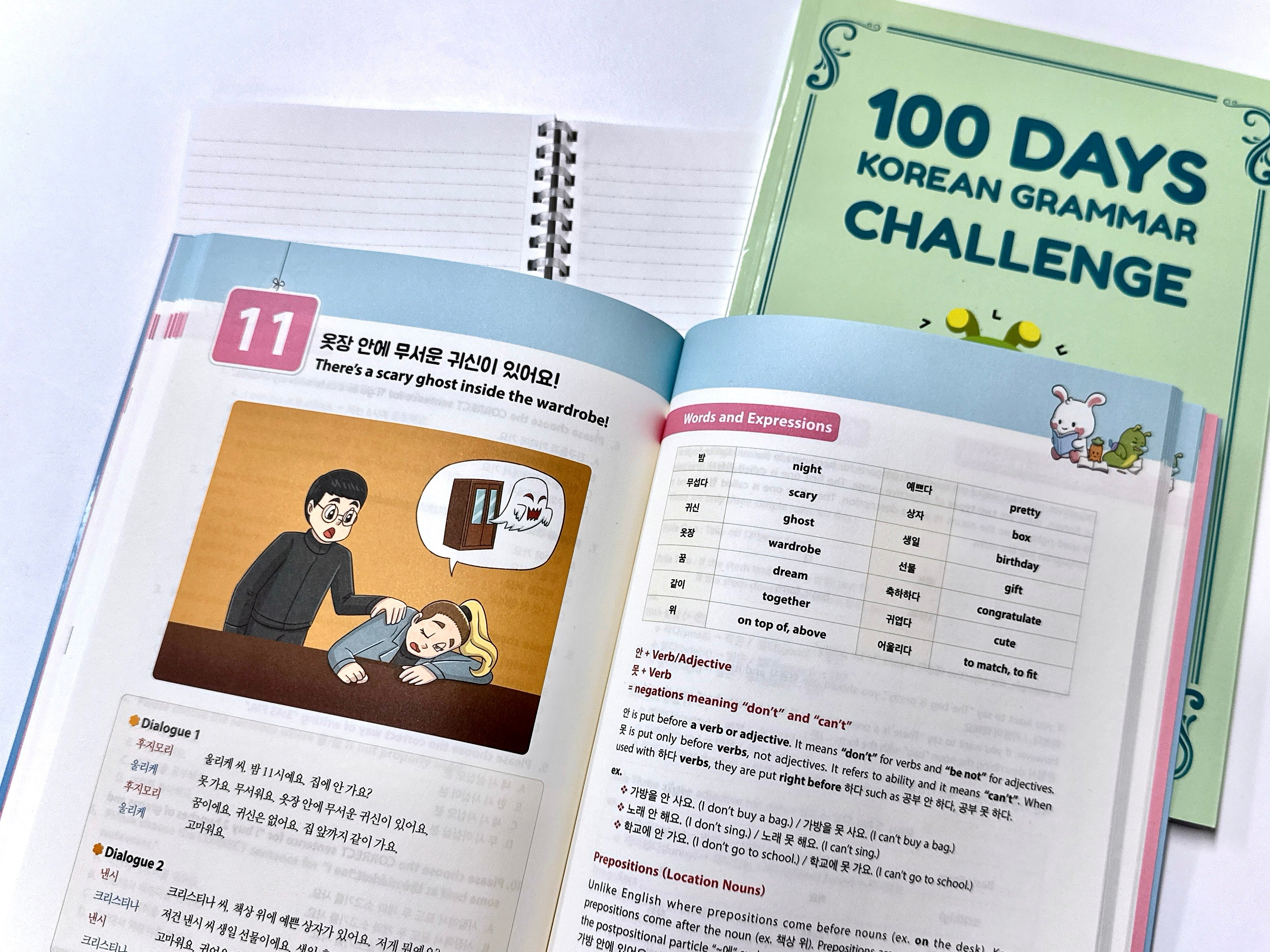Korean For All 1 Chapter 11: 안 / 못 + Verb/Adjective, Adjective + ㄴ/ 은/ 는, Adjective + 아/어요

Talking About Locations & Adjectives in Korean – Mastering Descriptions!
Today, we’ll learn:
✅ How to use prepositions to describe locations
✅ The difference between 안 vs. 못 (negative expressions)
✅ How to conjugate adjectives in Korean
✅ Essential descriptive words to express emotions, places, and things
1. Essential Vocabulary – Talking About Places & Feelings
Before we jump into grammar, let’s go over some important words!
| English | Korean | Pronunciation |
|---|---|---|
| Night | 밤 | bam |
| Scary | 무섭다 | museopda |
| Ghost | 귀신 | gwisin |
| Wardrobe | 옷장 | otjang |
| Dream | 꿈 | kkum |
| Together | 같이 | gachi |
| Pretty | 예쁘다 | yeppeuda |
| Gift | 선물 | seonmul |
| Cute | 귀엽다 | gwiyeopda |
| To match | 어울리다 | eoulrida |
📌 Useful Expressions:
- “귀신이 있어요.” (There is a ghost.)
- “꿈을 꿔요.” (I have a dream.)
- “꽃이 예뻐요.” (The flowers are pretty.)
2. Grammar Spotlight: 안 vs. 못
Korean has two different ways to say "not" or "can't":
✔️ 안 is used to say “don’t” (a choice).
✔️ 못 is used to say “can’t” (due to inability or restrictions).
Examples:
- 가방을 안 사요. (I don’t buy a bag.)
- 노래 안 해요. (I don’t sing.)
- 학교에 못 가요. (I can’t go to school.)
- 가방을 못 사요. (I can’t buy a bag.)
💡 TIP: Use 안 for things you choose not to do and 못 for things you cannot do due to a reason (e.g., lack of time, skill, or an allergy).
3. How to Describe Where Things Are
In English, prepositions go before the noun (on the table). But in Korean, they come after the noun!
| English | Korean | Example Sentence |
|---|---|---|
| In front of | 앞 | 학교 앞에 가게가 있어요. (There is a shop in front of the school.) |
| Behind | 뒤 | 집 뒤에 산이 있어요. (There is a mountain behind the house.) |
| On top of | 위 | 책상 위에 책이 있어요. (There is a book on the desk.) |
| Below | 아래 | 책상 아래에 가방이 있어요. (There is a bag under the desk.) |
| Inside | 안 | 가방 안에 책이 있어요. (There is a book inside the bag.) |
| Outside | 밖 | 집 밖에 차가 있어요. (There is a car outside the house.) |
| Next to | 옆 | 학교 옆에 공원이 있어요. (There is a park next to the school.) |
| Between | 사이 | 학교와 가게 사이에 은행이 있어요. (There is a bank between the school and the shop.) |
🎯 Practice: Try describing where things are in your room in Korean!
4. Adjective Conjugation – Describing People & Things
Korean adjectives change based on how they are used. There are two main forms:
1️⃣ Descriptive Form (형용사): Used to describe a state.
- 예쁘다 → 예뻐요 (It’s pretty.)
- 크다 → 커요 (It’s big.)
2️⃣ Attributive Form (관형사): Used before a noun.
- 예쁘다 → 예쁜 꽃 (A pretty flower.)
- 크다 → 큰 집 (A big house.)
More Examples:
| Basic Form | Descriptive Form | Attributive Form |
|---|---|---|
| 작다 (small) | 작아요 (It’s small.) | 작은 방 (A small room.) |
| 바쁘다 (busy) | 바빠요 (I’m busy.) | 바쁜 사람 (A busy person.) |
| 맛있다 (delicious) | 맛있어요 (It’s delicious!) | 맛있는 음식 (Delicious food.) |
| 귀엽다 (cute) | 귀여워요 (It’s cute!) | 귀여운 강아지 (A cute puppy.) |
📌 Practice Tip: Try using both forms of adjectives in your own sentences!
5. K-Culture Corner – Beauty Standards in Korea
In Korea, beauty is a big part of daily life. People often talk about clear skin, slim bodies, and trendy styles as ideal looks.
📌 Did you know?
- The Korean plastic surgery market was worth $1.7 billion in 2023 and is expected to grow to $5.19 billion by 2032!
- 1 in 3 Korean women in their 20s and 30s have had cosmetic procedures.
- Many teens feel pressure to look perfect, even getting surgeries as graduation gifts.
💡 Reminder: True beauty comes from confidence and kindness! Love yourself just the way you are. 💖
6. Your Homework!
✅ Practice describing objects in your house using adjectives.
✅ Complete exercises on pages 108-110 in your textbook.
✅ Watch a Korean drama and write down any adjectives you hear!
💡 For extra practice, check out our Soo House app!
Meet other learners and improve your Korean skills!

Click: Home - With Love From Korea – SooandCarr

Study & Connect via Soo House app
Click: Soo House
-
Posted in
korean grammar, level 1



